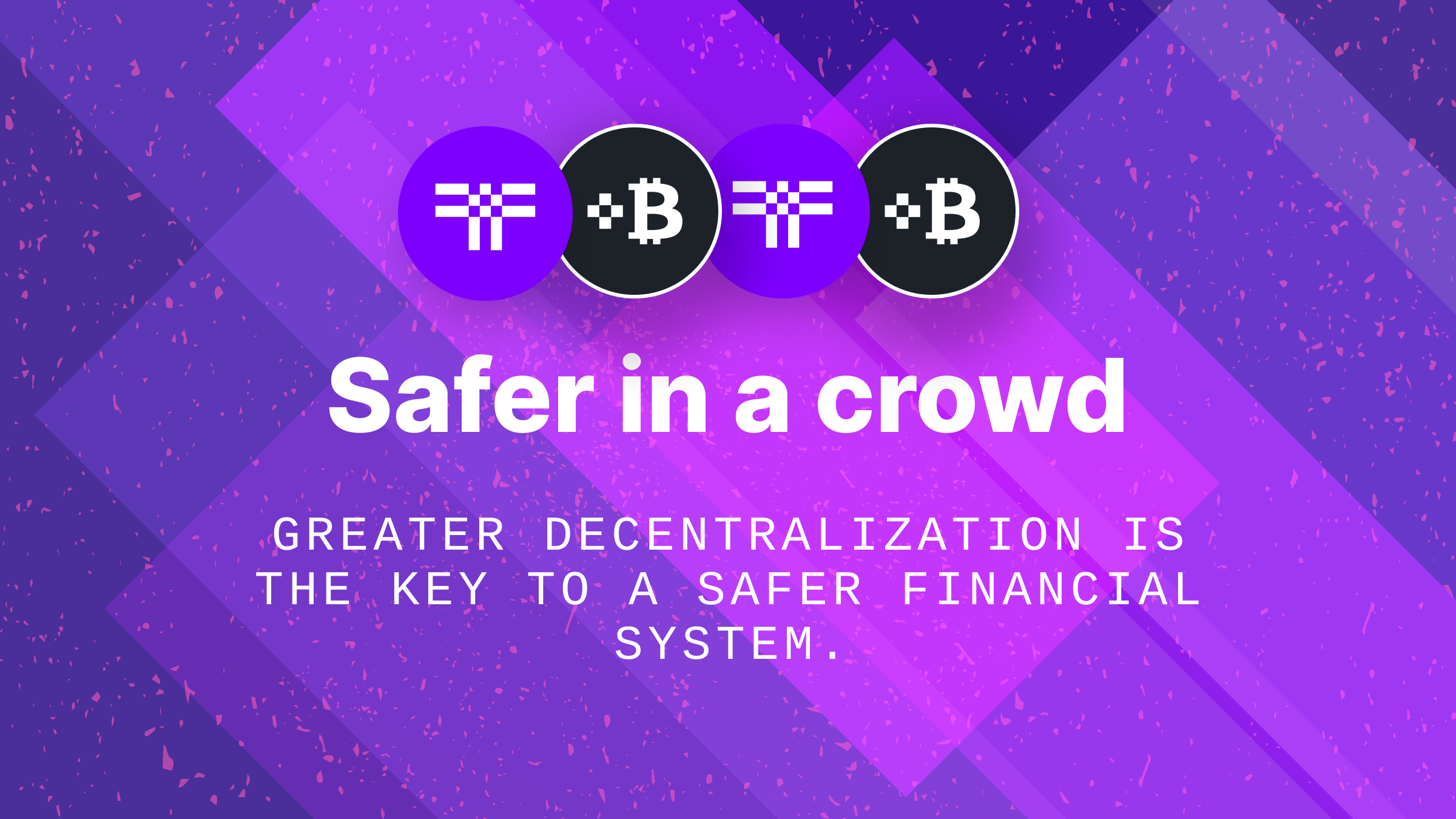Safer in a crowd: Greater decentralization is the key to a safer financial system

In the weeks following the implosion of FTX and Alameda Research, it’s not uncommon to hear condolences on the death of Bitcoin or crypto at large. They’re wrong, and it’s time to seize the opportunity to set the record straight.
Let’s start with the first and most obvious point: Whatever sins Sam Bankman-Fried and his associates committed had nothing to do with either Bitcoin or with decentralized finance. In fact, it’s important to state unequivocally that in a fully decentralized world, they would not have been possible.
It’s not for us to claim that decentralization would or could have outright prevented a crypto market correction caused by overinflated asset prices. But it would certainly be a much better alternative.
From what we’ve learned so far, FTX’s demise was at its heart the result of mismanagement – and possibly large-scale fraud – which triggered a liquidity crisis that in turn prompted an investor panic. This is what is known in other contexts as a run on the bank.
Under lock and cryptographic key
How would decentralization stop that from happening?
In traditional finance, inventors must entrust their assets to banks, brokerages and other gatekeeping entities. The assumption is that because these institutions are big and regulated and have reputations to maintain, they will think twice before defrauding their customers.
Along came blockchain and the programmable smart contract. At last, we could replace the safety assurances of the intermediaries who had dominated the system for centuries with code and cryptography. Decentralized Finance (DeFi) was born.
Sounds good, right? Except the world didn’t become fully decentralized overnight. Lots of centralized elements remained – and remain to this day. And lots of centralized protocols arose that promised to help the crypto newbie navigate this new financial landscape safely.
Despite the obvious advantages offered by decentralized exchanges (DEXs) – lower fees, transparency, user control over keys – these centralized marketplaces continued to command the bulk of crypto trading volumes.
But while these centralized exchanges were using the tools of DeFi, they were not themselves decentralized. This is also true of other projects, including early Bitcoin-to-Ethereum bridges: they relied on centralized custodians rather than code and cryptography to safeguard assets.
Then 2022 happened.
Last year’s bridge hacks and CEX disasters may have wiped out billions of dollars in value, but they also served as a timely reminder of two important truths: first, that a system is only as decentralized as its most centralized point; and second, that all centralization comes with risk.
Ironically, just a couple of weeks before the news broke about FTX and Alameda, SBF issued a blueprint for DeFi regulation that infuriated DEX founders, who said he should have directed their attention to centralized platforms instead.
On centralized crypto platforms, unscrupulous actors have been able to operate free from scrutiny in a way they could not in either traditional finance or DeFi. Banks are watched by regulators. Decentralized protocols, because they operate in full view, are policed by what I would consider a far larger and tougher force: the community. There’s safety in the crowd.
Why radical transparency prevents radical criminality
In a room without corners, there’s nowhere to hide. That’s equally true of a fully decentralized, open-source system.
The problem with FTX is that investors didn’t know how their funds were being used. As it turned out, we had a Peter-borrowing-from-Paul situation, where customer deposits were being used to fund various activities on the part of both FTX and Alameda. If everything had been on-chain, there would have been no way to hide any of this, unless the community had agreed to shift funds into a zero-knowledge pool. And no DeFi community would vote for anything so patently dishonest.
FTX lawyers told a Delaware bankruptcy court that SBF instructed FTX co-founder Gary Wang to build a secret back door into FTX so Alameda could borrow client funds from the exchange without permission. This too would have been impossible in a decentralized system. Using technology to hide things from auditors is the antithesis of what DeFi was invented to do.
Transparency serves another purpose too: it can prevent panic.
If you have a central bank account holding other people’s funds, there is always the potential that something will spook your depositors into demanding repayment all at once. In a decentralized exchange, investors are in charge of their own assets, so there is no chance of an old-fashioned bank run.
So why have centralization at all?
Good question. Why isn’t all of DeFi decentralized?
Two reasons. One is there are still technical limitations in areas like price discovery and search. The other is that human beings are greedy – they tend to try to gather power and influence to themselves during bull markets – hence the emergence of crypto “whales” in 2020 and 2021.
But that doesn’t mean we shouldn’t be doing everything we can to move toward widespread decentralization. Right now, we should be working to minimize the need to trust third parties whenever possible in the projects we build.
Time will tell if 2022’s upheavals will spell the end for centralized exchanges. But regardless, last year’s events provided the ultimate proof point for DeFi. If we want to build a new financial system that is resilient and can win the trust and adoption of billions of people, we must build the decentralized infrastructure to support that system.
If we do that, DeFi will continue to grow – and as it does, it will command more and more seats at the table. The more people adopt it, the stronger the system will become. There is safety in numbers.
This impetus for truly decentralized financial infrastructure is a driving force behind the creation of tBTC. Threshold has accelerated the launch of v2 of its secure, fully decentralized Bitcoin-to-Ethereum bridge to the fastest possible speed – while taking care to prioritize safety and security.
The tBTC v2 protocol is a fully decentralized bridging solution that opens the world of DeFi to Bitcoin holders. Open-source and accessible to all, it offers a secure avenue to Ethereum protected by cryptography and code, not individuals.
Learn more in this short introductory video, and join us in the Threshold Discord, follow Threshold on Twitter or check out our public Github for more information and latest updates.

